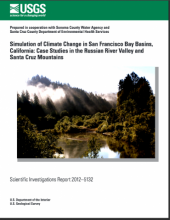Simulation of Climate Change in San Francisco Bay Basins, California: Case Studies in the Russian River Valley and Santa Cruz Mountains

As a result of ongoing changes in climate, hydrologic and ecologic effects are being seen across the western United States. A regional study of how climate change affects water resources and habitats in the San Francisco Bay area relied on historical climate data and future projections of climate, which were downscaled to fine spatial scales for application to a regional water-balance model. Changes in climate, potential evapotranspiration, recharge, runoff, and climatic water deficit were modeled for the Bay Area. In addition, detailed studies in the Russian River Valley and Santa Cruz Mountains, which are on the northern and southern extremes of the Bay Area, respectively, were carried out in collaboration with local water agencies. Resource managers depend on science-based projections to inform planning exercises that result in competent adaptation to ongoing and future changes in water supply and environmental conditions.
Results indicated large spatial variability in climate change and the hydrologic response across the region; although there is warming under all projections, potential change in precipitation by the end of the 21st century differed according to model. Hydrologic models predicted reduced early and late wet season runoff for the end of the century for both wetter and drier future climate projections, which could result in an extended dry season. In fact, summers are projected to be longer and drier in the future than in the past regardless of precipitation trends. While water supply could be subject to increased variability (that is, reduced reliability) due to greater variability in precipitation, water demand is likely to steadily increase because of increased evapotranspiration rates and climatic water deficit during the extended summers. Extended dry season conditions and the potential for drought, combined with unprecedented increases in precipitation, could serve as additional stressors on water quality and habitat.
By focusing on the relationship between soil moisture storage and evapotranspiration pressures, climatic water deficit integrates the effects of increasing temperature and varying precipitation on basin conditions. At the fine-scale used for these analyses, this variable is an effective indicator of the areas in the landscape that are the most resilient or vulnerable to projected changes. These analyses have shown that regardless of the direction of precipitation change, climatic water deficit is projected to increase, which implies greater water demand to maintain current agricultural resources or land cover. Fine-scale modeling provides a spatially distributed view of locations in the landscape that could prove to be resilient to climatic changes in contrast to locations where vegetation is currently living on the edge of its present-day bioclimatic distribution and, therefore, is more likely to perish or shift to other dominant species under future warming. This type of modeling and the associated analyses provide a useful means for greater understanding of water and land resources, which can lead to better resource management and planning.
Flint, L.E., and Flint, A.L., 2012, Simulation of climate change in San Francisco Bay Basins, California: Case studies in the Russian River Valley and Santa Cruz Mountains: U.S. Geological Survey Scientific Investigations Report 2012–5132, 55 p.
